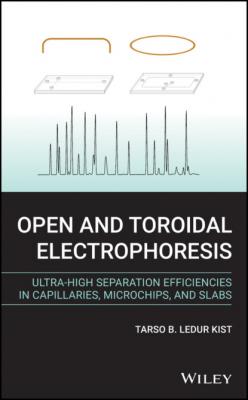Open and Toroidal Electrophoresis. Tarso B. Ledur Kist
Читать онлайн.| Название | Open and Toroidal Electrophoresis |
|---|---|
| Автор произведения | Tarso B. Ledur Kist |
| Жанр | Химия |
| Серия | |
| Издательство | Химия |
| Год выпуска | 0 |
| isbn | 9781119539247 |
Figure 1.3 Solvation of the sodium cation in water.
1.1.5 Dissociation
Ionic liquids and ionic solids are predominantly made by cations and anions that are held together by electrostatic attraction. This is the state of salts and even some bases and acids. They tend to stay in this state when mixed with most solvents at room temperature. The thermal motion of the solvent molecules, even at room temperature, continuously pushes ions from the edges and corners of these ionic solutes due to inelastic collisions. In most solvents the electric restoring force, given by equation 1.1, pulls the the ions back. Within water, however, two things happen:
1 The detached ions are immediately subjected to solvation
2 The restoring force is much weaker because the relative permittivity () of water is very high (equation 1.1).
These two properties of water make it a very good solvent for the dissociation of ionic liquids or ionic solids at room temperature.
As well as looking at the forces involved, another way to understand the unique ability of water to dissociate ionic liquids and solids is to examine the energies involved. Again, suppose that an ion is momentarily separated by thermal energy from a vertex or edge of a small neutral crystal stone of a solute. The detached ion is then immediately solvated and is initially positioned at distance
(1.2)
This is the energy necessary to move the ion with charge
Therefore, a large quantity of ionic liquids and ionic solids, with molecular formula
The maximum solubility of ionic liquids and ionic solids is an important parameter in practical preparative and analytical applications of ESTs. For instance, some analytes are not soluble above certain concentrations, which must be known to avoid errors in the analysis. The same is true for buffers within certain temperature ranges. The maximum solubilities of analytes and buffers at a given temperature are tabulated in the literature and are usually expressed in grams per 100 milliliters of solution.
Another way to express maximum solubility is the so-called solubility product, which is defined as
The above paragraphs merely give qualitative discussions of the phenomena involved in dissociation reactions. Gibbs free energy change can actually be used to accurately predict if a reaction (dissolution with dissociation) may occur or not (see Section 1.1.8). It is fair to make a clear distinction between dissociation and ionization. The so-called ionic substances (liquids or solids) are predominantly in the form of cations and anions. Therefore, their solubilization in water is merely dissolution with dissociation. On the other hand, a large number of substances are predominantly in the form of covalent liquids, solids, or even gases. Only when placed in water (and a few other solvents) do they ionize to the form of cations and anions. In this case the process is better called dissolution by ionization.
1.1.6 Ionization
Water molecules constantly collide with each other inside pure liquid water. In some collisions a proton of one water molecule attaches to the sp3 non-bonding orbital of a second water molecule, as given by: 2H2O → H3O+ + OH−. The generated ions (hydron and hydroxyl) are then immediately solvated and in a fraction of the events the solvated ions move apart as a cation (H3O+) and an anion (OH−), driven by thermal energy and facilitated by the low restoring force, which occurs because of the high relative permittivity
This phenomenon is the so called self-ionization of water, i.e. water itself undergoes ionization due to its remarkable properties (water falls victim to itself). Moreover, this reaction shows the amphiprotic nature of water, as it possesses both the characteristics of a Brønsted acid and base.
Molecules carrying acidic and basic functional groups are also subjected to ionization when introduced into water. For carboxylic acids (e.g., formic acid) there are at least two possible reactions for their ionization:
(1.4)
(1.5)
where the source of the OH− ions is the self-ionization
